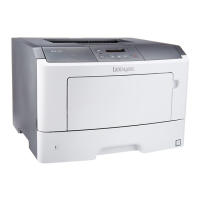General information
The Lexmark
TM
MS410d and MS410dn are single‑function monochrome laser printers designed for small and mid‑sized
workgroups. All information in this service manual pertains to all models unless explicitly noted.
The printers are available in the following models:
Model Configurations Machine type / model
MS410d Duplex printer 4514‑420
MS410dn Duplex printer, network capable 4514‑430
The diagnostic information in this manual leads you to the correct field replaceable unit (FRU) or part. Use the error
code charts, symptom index, and service checks to determine the symptom and then repair the failure. After you
complete the repair, perform tests as needed to verify the repair.
To begin diagnosing a problem, go to “Diagnostic information” on page 31. See “Repair information” on page 127
for information about removing and reinstalling parts. See “Parts catalog” on page 226 to help identify parts.
Media guidelines
Paper guidelines
Selecting the correct paper or specialty media reduces printing problems. For the best print quality, try a sample of the
paper or specialty media before buying large quantities.
Paper characteristics
The following paper characteristics affect print quality and reliability. Consider these characteristics when evaluating
new paper stock.
Weight
The standard printer trays can automatically feed paper weights up to 90‑g/m
2
(24‑lb) bond grain long paper. The
optional trays can automatically feed paper weights up to 120‑g/m
2
(32‑lb) bond grain long paper. The multipurpose
feeder can automatically feed paper weights up to 163‑g/m
2
(43‑lb) bond grain long paper. Paper lighter than
60 g/m
2
(16 lb) might not be stiff enough to feed properly, causing jams. For best performance, use 75‑g/m
2
(20‑lb)
bond grain long paper. For paper smaller than 182 x 257 mm (7.2 x 10.1 inches), it is recommended to use 90 g/m
2
(24 lb) or heavier paper.
Note: Two‑sided printing is supported only for 60–90‑g/m
2
(16–24‑lb) bond paper.
Curl
Curl is the tendency for paper to curl at its edges. Excessive curl can cause paper feeding problems. Curl can occur after
the paper passes through the printer, where it is exposed to high temperatures. Storing paper unwrapped in hot, humid,
cold, or dry conditions, even in the trays, can contribute to paper curling prior to printing and can cause feeding
problems.
4514-420, -430
General information
21

